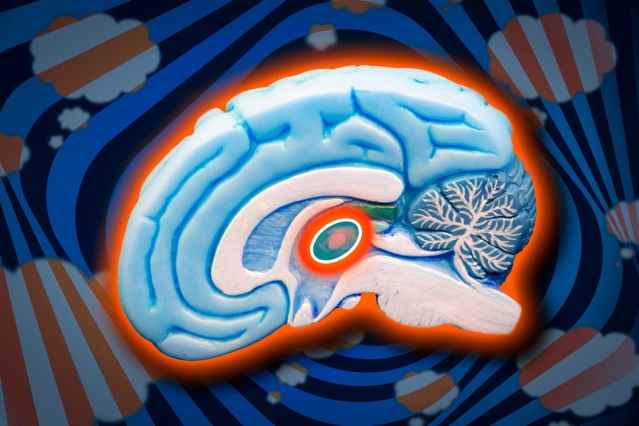
The brain’s thalamic reticular nucleus (TRN), highlighted in the center, is responsible for blocking out distracting sensory input. “For autism, schizophrenia, and other neurodevelopmental disorders, it seems like TRN dysfunction may be involved in some patients,” Guoping Feng says. | Illustration: Jose-Luis Olivares/MIT
Study reveals a basis for attention deficits
New findings could help scientists develop treatments for ADHD and other disorders.
Source: [Anne Trafton | MIT News Office, March 23, 2016]
More than 3 million Americans suffer from attention deficit hyperactivity disorder (ADHD), a condition that usually emerges in childhood and can lead to difficulties at school or work.
A new study from MIT and New York University links ADHD and other attention difficulties to the brain’s thalamic reticular nucleus (TRN), which is responsible for blocking out distracting sensory input. In a study of mice, the researchers discovered that a gene mutation found in some patients with ADHD produces a defect in the TRN that leads to attention impairments.
The findings suggest that drugs boosting TRN activity could improve ADHD symptoms and possibly help treat other disorders that affect attention, including autism.
“Understanding these circuits may help explain the converging mechanisms across these disorders. For autism, schizophrenia, and other neurodevelopmental disorders, it seems like TRN dysfunction may be involved in some patients,” says Guoping Feng, the James W. and Patricia Poitras Professor of Neuroscience and a member of MIT’s McGovern Institute for Brain Research and the Stanley Center for Psychiatric Research at the Broad Institute.
Feng and Michael Halassa, an assistant professor of psychiatry, neuroscience, and physiology at New York University, are the senior authors of the study, which appears in the March 23 online edition of Nature. The paper’s lead authors are MIT graduate student Michael Wells and NYU postdoc Ralf Wimmer.

